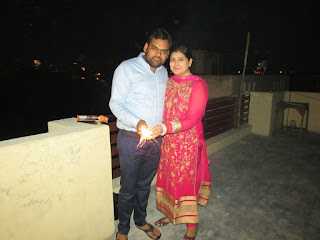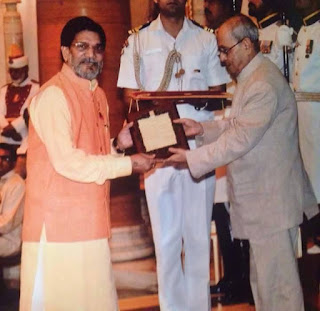On becoming the Minister of External Affairs, Sushma
Swaraj, last year in May, 2014, used the
term “Out of the Box” diplomacy which PM Narendra Modi’s government would like
to pursue in the conduct of India’s international relations, particularly with
its neighbors. Accordingly, both PM Narendra Modi and EAM Sushma Swaraj have
been pursuing the foreign policy goals of India over the last one and a half years
with a new approach and inputs wherever required and possible on one hand and
carrying forward the traditional tenets of its international engagement.
Obviously, foreign policy is an on-going process and will continue to meet the
challenges, both old and new.
The immediate provocation to write on the “Out of the Box”
diplomacy with regard to Indo-Pak relations is PM Narendra Modi’s surprise
visit to Lahore to meet PM Nawaz Sharif on December 25, 2015, ostensibly, to
wish PM Nawaz Sharif a happy birthday and join the festivities of the marriage
of PM Nawaz Sharif’s granddaughter. It is said that PM Narendra Modi has a
penchant for high drama. Why not? He is a leader by his own right whose
government enjoys clear majority in the Lok Sabha with overwhelming popular
mandate. PM Narendra Modi can afford to undertake, as assessed by Vivek Katju
an Indian diplomat and Pakistan expert, who termed it as “innovative diplomacy”
with “a quest to make history”. Ever since, PM Modi took over in May, 2014, he
has given much needed impetus and visibility to the Indian diplomacy by taking
personal initiatives and establishing personal rapport with world leaders to
protect and promote Indian interests. Obviously, it requires an “Out of the
box” approach leaving aside some of the diplomatic nothings, the so called
protocol niceties. PM Narendra Modi’s surprise visit to Lahore on December 25
was a diplomatic master-stroke, keeping in line with his work style and “a
quest to make history”. It is simply an academic exercise to discuss as to how
it happened? I think, it was thought and planned by PM Modi himself. It is
possible he kept NSA Ajit Doval and FS Dr. S. Jaishankar on the loop. He knew
in his mind how PM Nawaz sharif will respond to his birthday greetings from
Kabul and he would immediately grab the opportunity. It exactly happened the
way it was visualized by PM Modi. The special Indian Air force plane was
deployed to take care of the security requirements. Befitting gifts were
available in the gifts inventory for the granddaughter of Nawaz Sharif. The
Indian side has explained how PM Modi telephoned PM Sharif to wish him happy
birthday and how, in turn, he invited him to Lahore on his way back from Kabul
to have tea with him and join the marriage festivities of his grand-daughter.
The Pakistani side explained it with a little twist, perhaps to cater to the
local needs that PM Modi telephoned to say happy birthday to PM Sharif and
desired to make a brief halt at Lahore on his way back from Kabul to do so.
Whatever the case, the purpose was served as mused by PM Narendra Modi to
“completely transform India-Pak relations” in the words of an enlightened
commentator.
It needs no elaboration that India-Pakistan relations are
extremely complex and difficult from day one of their becoming independent
nations in August, 1947. Most of the Hindus could not digest the two-nation
theory on the basis of which Pakistan came into existence. Some of them are
still talking of Akhand Bharat. Pakistan and also Bangladesh are independent
and sovereign states and will remain so. My advice to the likes of Ram Madhav
of RSS is to study the thought provoking book “Thoughts on Pakistan” written by
the finest mind of India Dr. B.R. Ambedkar well before the partition of India.
The rest is history. The Kashmir issue is the core issue, as stated by
Pakistan, which is the left-over agenda of partition. We may or may not admit
it but it is a reality. Despite the “Stand-still Agreement”, Pakistan invaded
Kashmir and tried to annex it by force in 1948 itself. Understanding the
situation, on Kashmir’s legal accession to India, leaders like Sardar Patel,
Shyama Prasad Mukherjee, Govind Ballabh Pant and also Babasaheb Ambedkar
advised PM Jawaharlal Nehru to throw out Pakistani invaders by force and kill
the issue. But PM Nehru’s thinking was at variance. He was seeing the issue through the prism of
the eyes of Lord Mountbatten and Sheikh Abdullah which, it seems, was a big
mistake. Dr. Ambedkar, though he was not involved in matters related to foreign
policy when he was the Law Minister in the interim government of PM Nehru,
suo-motto gave his views on the Kashmir issue. I quote from an article written
by Dr. K. Jamnadas “Kashmir Problem from Ambedkarite Perspective,” Even about Kashmir, the issue on which we are fighting, who is
in the right and who is in the wrong. The real issue to my mind, he said, is
not who is in the right but what is right and he observed: "... my view
has always been that the right solution is to partition Kashmir. Give the Hindu
and Buddhist part to India and the Muslim part to Pakistan as we did in the
case of India. We are really not concerned with the Muslim part of Kashmir. It
is a matter between the Muslims of Kashmir and Pakistan. They may decide the
issue, as they like. Or if you like, divide it into three parts; the Cease-fire
zone, the Valley and the Jammu-Ladakh Region and have a plebiscite only in the
Valley. What I am afraid of is that in the proposed plebiscite, which is to be
an overall plebiscite, the Hindus and Buddhists of Kashmir are likely to be
dragged into Pakistan against their wishes and we may have to face the same
problems as we are facing today in East Bengal."
Dr. Ambedkar was a genius. The solution given by him was
pragmatic and was not based on misplaced emotions. Had PM Jawaharlal Nehru
listened to him, both the newly independent countries would not have suffered
the economic burden of defense of the long border and also the subsequent full
blown wars and often repeated border skirmishes resulting in constant hostility
between the two neighbors. Even after 68 long years, the solution still lies
somewhere close to Dr. Ambedkar’s thinking. PM Indira Gandhi and PM Zulfikar
Ali Bhutto, it is said, agreed in 1972 at the time of Simla Agreement to
convert the Line of Control (LOC) into international border and settle the core
issue of Kashmir. It could not happen. The Nobel Peace Prize eluded them. PM
Atal Bihari Vajpayee was interested in making history and he tried with PM
Nawaz Sharif and President Pervez Musharraf but failed. PM Manmohan Singh and
President Pervez Musharraf picked up the threads and thought of making the LOC
and International border between India and Pakistan “irrelevant” and become the
contenders for the coveted peace prize. But again it was not to be. Somebody
else is destined to make history. Will they be PM Narendra Modi and PM Nawaz
Sharif? Only time will tell.
We all know that the Kashmir issue cannot be solved by either
side
by force. Both India and Pakistan are nuclear powers. The stakes are too
high. Nobody will be interested in making it a flash point for the unimaginable
holocaust. The leaderships of both India and Pakistan and the people on both
the sides and also the international community are not oblivious of these
ground realities. The international scenario is changing fast in view of cross
border terrorism and regional conflicts. The challenges of development and
environment are needed to be addressed to save humanity. The “Out of the Box”
solutions and approaches are needed. The festering problem of Kashmir and the
emerging situation in Afghanistan needs immediate attention. Both India and
Pakistan are required to rise to the occasion to ward of the imminent dangers
of allowing the situation to worsen.
Given the background of PM Narendra Modi, he has an image of
a
hawk in Pakistan. It becomes all the more difficult for him to do business
with Pakistani leadership particularly that of the Pak army and Islamic
fundamentalists. On the other hand, it appears that PM Narendra Modi intends to
steal the show and make history by adopting an “Out of the Box” approach. He
invited PM Nawaz Sharif to his swearing in ceremony in May, 2014 along with his
other SAARC counterparts, registering diplomatic deftness on his part. In spite
of usual ups and downs in relations with Pakistan, PM Narendra Modi kept the
diplomatic routes open. From Ufa to Paris, he did not leave any opportunity to
engage Pakistan in constructive dialogue. Addressing the army commanders
recently, PM Modi said, setting the agenda, “We are engaging Pakistan to try
and turn the corners of history, bringing an end to terrorism, build peaceful
relations, advance cooperation and promote stability and prosperity in the
region.” The NSAs of India and Pakistan,
Ajit Doval and Nasser Janjua respectively met in Bangkok followed by the visit
of EAM Sushma Swaraj to Islamabad in December itself to pave the way for
“Comprehensive Bilateral Dialogue” which was stalled due to the vicious
bitterness and mistrust existing in the relationship with Pakistan. PM Narendra
Modi’s unscheduled visit to Lahore on December 25 on the birthday of PM Nawaz
Sharif, PM Atal Bihari Vajpayee, and Quaid-e-Azam Muhammad Ali Jinnah was a
diplomatic masterstroke to engage Pakistan in the process of creating history.
Let us hope, the process continues and the desired results obtained.
It is not an easy task. Pakistan has to tone-down the
rhetoric of “Kashmir is the jugular vein of Pakistan” and shed and shun the
policy of exporting terrorism. India being a big country in the region should
be more accommodative and magnanimous in dealing with its estranged brother.
The government of PM Narendra Modi, with a clear majority in the Lok Sabha,
should create political and diplomatic consensus on the issues of conflict and
contention within the country. The civil society should be prepared to engage
with Pakistan by encouraging people to people contacts. Cultural bonds should
be nurtured. The opportunities for the two way trade between the two countries
should be explored, identified and exploited. The likes of Ram Madhav, the
votary of ‘Akhand Bharat’, should be asked to shut up. The forces of
understanding and friendship should be unleashed to create a conducive
atmosphere for meaningful dialogue to solve the vexed problems to mutual
benefit and advantage.
It is easier said than done. But there is, it seems, a
growing feeling of tiredness on both sides. There is a growing realization that
force and undiplomatic methods cannot solve the problems and challenges
generated by the history. Let us consider and opt for the policy of ‘give and
take’ as advised by Dr. B.R. Ambedkar, of course, with necessary adjustments
which may be required to address the current situation. Let us wish the
leaderships of both India and Pakistan under the stewardship of PM Narendra
Modi and PM Nawaz Sharif all the very best in the New Year and help them in
making history for the people of India and Pakistan and the world at large.
आ गैरीअत के परदे इक बार फिर उठा दें;
बिछडों को फिर मिला दें; नक़्शे दुई मिटा दें ,
सुन्नी पड़ी हुई है मुद्दत से दिल की बस्ती;
आ इक नया शिवालय इस देश में बना दें !
Happy New Year to the people of India and Pakistan.
























